ALBERT EINSTEIN
 (1879 - 1955)
(1879 - 1955)
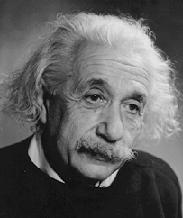
CONTENTS
 Einstein: An Overview Einstein: An Overview
 His Life and Works His Life and Works
 Special Relativity Special Relativity
 General Relativity General Relativity
 Links to Einstein' Writings and More Links to Einstein' Writings and More
Information
|
Einstein wanted to unify all branches
of physics around a cohesive set of simple laws, ones that described physical
behavior in all possible settings.
He was initially troubled by the
inherent contradictions between the classic understanding of the
relativity
of the laws of mechanics (Galileo and Newton) and the newer view of the
absolute
character of the laws of electromagnetism (Maxwell). With his theory
of special relativity (1905) he demonstrated mathematically that
electromagnetism functions with the same relativity of classic mechanics--because
of the elasticity of space and time! This theory seemed counter-intuitive
at the time, though experiments over the next quarter of a century gave
clear demonstration of the correctness of his theory.
A major difficulty with his theory
of special relativity was that it applied only to "special" situations
(thus its name), that is, situations where light was being measured by
an observer whose momentum was constant. Einstein knew that situations
of perfectly constant momentum (unchanging speed and direction) are rare.
Normally our movements are in constant flux, accelerating, decelerating,
turning, etc. as we encounter varying forces acting externally upon our
movements. Einstein thus set out to define a more comprehensive theory
of mechanical and electromagnetic physics, one he called general relativity.
In this quest for a general theory
of relativity it was the issue of gravity that received his greatest attention.
Through a number of mental "games," he came up with the notion that gravity
is not really a separate force but merely a result of the structuring of
the movement of objects through what he called
spacetime.
This too was counter-intuitive, in the sense that he was attempting to
describe a dimension of physical existence that had no exact parallels
in what we humans have ever been able to perceive directly. So he
used analogies. One of these was the analogy of the curve
that is always described on the surface of a globe when something attempts
to move along the globe's surface in a straight line. Gravity is
really only such a curvature in spacetime.
Another analogy was a rubber membrane
with a heavy iron ball nestled in the center of it--and the effect this
would have if we tried to roll a much smaller ball across the membrane
and past the iron ball in an attempt to reach the other side of the membrane.
Depending on how close the smaller ball came to the larger ball, it might
be led around and past the larger ball by the curvature of the membrane
around the ball--or if it came too close, the smaller ball might be drawn
in a circular path around the larger ball and finally into collision with
it. Einstein asserted that there was no gravitational "force" that
drew the the smaller ball into the orbit of the larger ball--only the curvature
(of spacetime) around the larger ball. Thus gravity was explained
as being (sort of) merely a curve in the flow of spacetime--a curve created
by the presence of concentrated matter/energy. And thus we could
calculate the effect of gravity without having to resort to the notion
of gravity itself, thus eliminating an unnecessary concept in physics and
thus further simplifying physics.
Thus with general relativity Einstein
saw himself moving the discipline of physics closer to a cohesive body
of laws, laws uniformly applicable in a variety of different physical settings.
By eliminating gravity as a separate concept he had certainly moved physics
closer to that goal.
But with the development of the field
of quantum mechanics Einstein felt that the move toward conceptual unity
was headed in the opposite direction. For the longest time he debated
the quantum theorists (Bohr, for instance)--until he had to admit that
their theoretical world worked--though in apparent contradiction to his
own world of relativity.
For the rest of his life he tried
to close the gap within physics created by the quantum revolution--though
seemingly without further success. |
|
|
Albert Einstein was born in Ulm,
Germany, in early 1879. The following year his family moved to Munich
where his father, Hermann, and uncle, Jacob Einstein, established a small
electical engineering operation.
Early Life
Einstein showed no particular aptitude
for formal schooling and was thought by his teachers to be a slow learner.
But he had a strong curiosity about the doings of his father's engineering
works--and his uncle Jacob was careful to teach young Albert some of the
mathematical principles involved in the workings of the electrical dynamos.
At the same time a maternal uncle, Caesar Koch, taught him basic principles
of science.
Problems in his father's company
forced the family to leave Germany--to settle in Milan, Italy. Albert
was sent back to school, this time in Switzerland. Eventually he
found his stride and in 1900 successfully completed a four-year course
of study at the Federal Polytechnique Academy in Zurich. Soon thereafter
he became a Swiss citizen and took a position in the Swiss Patent Office
in Bern.
In 1903 he married a classmate from
the Academy, Mileva Maric.
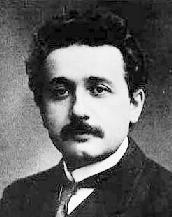 Special
Relativity: 1905 Special
Relativity: 1905
In 1905 Einstein entered for publication
in the monthly journal, Annalen der Physik, a number of articles
relating molecular action to heat, light, and body mass. These were
the foundational pieces for his Special Theory of Relativity. Immediately
the genius in these works was recognized, and University of Zurich awarded
him the Ph.D. for his work.
Einstein left his work at the Patent
Office and took up teaching, eventually becoming a full professor at the
University of Prague. Then in 1912 he returned to Switzerland to
a teaching position at the Federal Polytechnique in Zurich.
World War One: Family Turmoil
The years leading up to World War One
(1914) were a time of great contentment for Einstein, his wife and his
two sons, Hans Albert and Edward.
But World War One intervened to upset
this serene picture. In the spring of 1914 the family moved to Berlin
where Einstein had accepted a position at the University of Berlin.
That summer his wife and sons left on vacation for Switzerland, but when
the war broke out in September, they were unable to return to Berlin.
The physical separation eventually evolved into an emotional separation--and
Einstein and his wife divorced.
The growing tragedy of the war led
Einstein to an ever more vocal pacifist position--which put Einstein quite
out of step with his very nationalistic, even militaristic, professorial
colleagues. Einstein was appalled by the ability of the supposedly
highly civilized European nations to rationalize the massive murderousness
of the war effort.
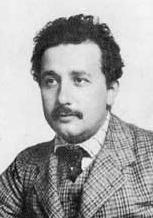 General
Relativity: 1916 General
Relativity: 1916
Nonetheless Einstein's work on a pet
project of his had been making headway and in 1916 he published an article
in Annalen der Physik entitled "The Foundation of the General Theory
of Relativity." Here he laid out the basic principles for a theory
that united a number of his special laws of relativity into a single General
Theory of Relativity.
In late 1918, with the end of the
"Great War," as World War One was then called, Einstein looked forward
to the rule of peace and reason within the West, and in Germany in particular.
In 1919, with a solar eclipse that
validated his theories about the action of light as it passed close to
a massive body, Einstein's fame became truly international in its extent.
A Growing Personal and Social Life
In that same year, 1919, he remarried--taking
for his wife his own widowed second cousin, Elsa, and fashioning a new
home with her and her two daughters.
Berlin in those days was a scene
of emotional-political turmoil, vented on the Communists and Jews who,
according to German ultra-nationalists, were supposedly conspiring to take
over the German nation. This was the beginning of very hard times
for Jews in Germany. It was at this time that Einstein, though a
religious agnostic, began to focus more on his own cultural Jewishness--by
taking up the Zionist cause. He even came to the United States in
1921 to raise money for the Palestine Foundation Fund, used to resettle
Jews in British-controlled Palestine (modern-day Israel).
Needless to say, he was much sought-after
as a lecturer on his new theories of physics and he found himself travelling
much over the next years, lecturing in Europe, America, and Asia.
In 1921 he was awarded the Nobel Prize for Physics.
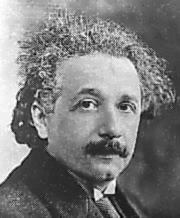 His
Quest for a Theory of Everything His
Quest for a Theory of Everything
Einstein was now focusing his thoughts
on the matter of how a simple principle stood behind the workings of the
whole universe. He was looking for a unified field theory--a theory
of "everything."
Unfortunately, the discovery of quantum
physicists (Bohr, Heisenberg and others) that there was a built-in indeterminacy
or uncertainty about the behavior of the fundamental particles of matter
(quanta) made Einstein's study of "everything" problematic at its
its very heart. Einstein himself refused to accept the uncertainty
principle as a final statement about the behavior of the universe's fundamental
material--and continued to look for a theory that could side-step this
uncertainty.
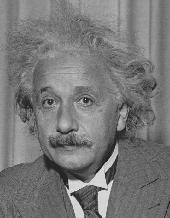 He
Leaves Germany for America He
Leaves Germany for America
In the meantime the very hard times
of the late 1920s and early 1930s touched even Einstein. The Zionist
program to resettle Jews in Palestine was getting unyielding oppostion
from the British authorities in Palestine--and violent opposition from
the Arabs living there. And in Germany, Hitler's Nazis were gaining
popularity by bashing Jews as national demons (along with international
capitalists, Communists, Socialists, Gypsies, homosexuals and a few other
categories of "undesireables"). Einstein's hope was also sinking
quickly that a new international legal order, embodied in the League of
Nations, would bring peace to the world. Increasingly the League
was proving itself unable to deal with the growing number of diplomatic
crises afflicting the world. Einstein grew bitter in his disappointment
over this failure.
In 1933, with Hitler's appointment
as Chancellor of Germany, Einstein renounced his German citizenship and
left the country. His mood now changed from one of pacifism to adamant
opposition to the Nazi regime, even calling on Europe to arm itself against
Hitler.
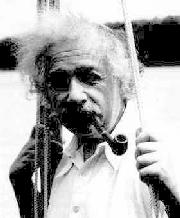 He
soon thereafter (October 1933) came to Princeton, New Jersey, to become
part of the faculty of the new graduate Institute for Advanced Study.
Here he lived quietly and routinely with his wife (until her death in 1936)--rarely
leaving Princeton over the years. Eventually he became an American citizen. He
soon thereafter (October 1933) came to Princeton, New Jersey, to become
part of the faculty of the new graduate Institute for Advanced Study.
Here he lived quietly and routinely with his wife (until her death in 1936)--rarely
leaving Princeton over the years. Eventually he became an American citizen.
World War Two and the Bomb
As war clouds gathered in Europe (1939)
Einstein was informed by his friend Niels Bohr that in accordance with
Einstein's theories, the uranium atom had been split, giving off a small
amount of its mass in the form of energy. This pointed to the thought
that this process could be--and most probably would be--controlled to produce
a bomb of catastrophic proportions. The question was--who would be
the first to achieve this goal: Germany or its enemies? Einstein
himself decided to write President Roosevelt to make him aware of the critical
challenge that nuclear power posed--and the need to develop atomic weaponry
before the Germans did. Thus was born the idea of the Manhattan Project.
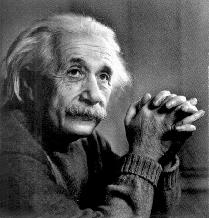 Einstein
himself was not part of the Manhattan Project in Los Alamos, New Mexico,
where America's atomic bombs were developed during the war years.
Nonetheless his own hand in developing the theoretical foundations underpinning
the nuclear age was quite evident to everyone. However, at war's
end, the pacifist in Einstein now reasserted himself, and Einstein's thoughts
now ran to the question of securing a world free from the terror of nuclear
arms--rather than to the challenge of staying ahead in the nuclear arms
race. Einstein
himself was not part of the Manhattan Project in Los Alamos, New Mexico,
where America's atomic bombs were developed during the war years.
Nonetheless his own hand in developing the theoretical foundations underpinning
the nuclear age was quite evident to everyone. However, at war's
end, the pacifist in Einstein now reasserted himself, and Einstein's thoughts
now ran to the question of securing a world free from the terror of nuclear
arms--rather than to the challenge of staying ahead in the nuclear arms
race.
Einstein Moves to the Sidelines
In his later years he remained focused
on the quest for a unified field theory. In 1950 Einstein published
a paper on the subject. But most physicists remained unconvinced
that his theories, though carefully worked out mathematically, were valid.
And this growing sense of separation
from the mainstream of physics and mathematics remained with Einstein all
the way to his death in Princeton in April of 1955. |
|
|
The Impossibility of a Moving Observer
Achieving the Speed of Light
In his earliest studies (1905), Einstein
focused himself on the question of what one would see if he could speed
himself up to a light wave so that the wave and the observer were travelling
at the same speed (186,000 miles per second) along parallel courses.
This would be quite fast of course! What would the observer see in
the light wave? Absolutely nothing--because the very quality of light
as a wave would be contradicted. From the point of view of an observer
moving at the speed of light a light wave would no longer be a wave--moving
up/down or back/forth. The wave would be frozen in movement, stilled
of any apparent action. From the point of view of the observer, the
wave would no longer be a wave, and the light would simply cease to be
light. This would be a contradiction to the law of physics which
states that there is no place or point in the universe at which the laws
of physics would not pertain. Thus the very idea of an observer ever
attaining the speed of light and thus causing its extinction is a logical
impossibility.
Just as logically impossible was
the idea of an observer even moving up toward the speed of light.
Experiments had demonstrated that the speed of light reaching an observer
remained constant (always 186,000 miles per second)--no matter what the
speed or direction of the observer. As the observer speeded up, something
in the relationship between light and the observer shifted in such a way
that light continued to reach him from the surrounding world at exactly
the same speed--irrespective of his own motion. From whatever point
of reference that a person observed the illuminated world around him, the
speed of light reaching him would always be the same. Thus we should
say that there was always an invariance in the speed of light reaching
an observer, no matter what his particular situation, no matter what his
particular frame of reference.
In other words, unlike sound waves
which are speeded up or slowed down as the sound source is pushed toward
us or or drawn away from us--light waves are sent out from their
source always at the same speed (186,000 miles or 300,000 kilometres
per second) irrespective of the momentum of the light source.
What Was It Then That Was Variable?
But some kind of variance must surely
occur as an observer's frames of reference varied. The variance could
not be in the speed of light--for that was a constant. Rather, the
variance would have to be in the nature of the frames of reference themselves,
frames of reference built on our understanding of space and time.
It was our notions of space and time, not light, that were the true variables.
The Relativity of
Simultaneity
For instance, how would this principle
of invariance then work on two observers, each watching a particular
event from a different vantage point of speed and direction--each simultaneously
observing the event from different frames of reference?
Einstein, in another thought experiment,
posited a train station example. Two bolts of lightning strike a
train as it is passing through a train station, one bolt hitting the front
of the train and one hitting the very rear of the train, each bolt leaving
a burn mark on the station platform showing exactly where the train was
when it took the two hits. To an observer on the platform both bolts
of lightining appear to have hit at exactly the same time. The observer
confirms this view by measuring off the distance between his point of observation
and
the two burn marks, noting that the distance is the same in each case.
The observer was standing exactly in the center of the two events and saw
them take place at exactly the same moment.
But a person standing in the very
middle of the train, saw the flash of light coming from the front of the
train just slightly before observing the flash coming from the rear of
the train. He confirms this observation that the two events did not
take place simultaneously by noting through careful measurement that he
had been standing in exactly the middle of the train.
Now, which of these two observers
was correct? The person on the platform or the person on the train?
Einstein said both were correct!
But we might be inclined to answer:
yes, but the person of the platform was standing at a stationary
position, which would logically seem to be the truer position. The
person on the moving train was moving toward the bolt that hit the front
of the train thus would naturally perceive that event first (the difference
of course being very small--in terms of the speed of light).
But Einstein argued that both observers
had an equal claim on the laws of physics from their respective frames
of reference. The laws of physics do not favor one frame of reference
over another.
Time Dilation
If we on earth were able to see a clock
in a rocket moving away from us at a very rapid rate, it would seem to
be lagging in comparison to our clocks on earth. With each second
of the rocket's rapid movement away from us it would take longer for sight
of the clock to reach us--thus the clock's seconds would appear to be slower
than our earth seconds.
But guess what? From the frame
of reference on the rocket ship, from the point of view of an observer
able to see a clock on earth, the earth clock would likewise appear to
be just as slow, for with each second of increasing distance between the
rocket and earth, it would take longer for a second on the earth to reach
the observer rocket.
Thus for both observers, the
clocks on the other frames of reference would both slower slower than their
own as they move away from each other. Einstein called this
time
dilation.
Length Contraction
By the same token, an attempt of an
earth observer to measure the length of the rocket as it rapidly moves
away from him will result in a shorter measurement than that which an observer
on the rocket itself would come up with (for him the rocket was a stationary
object, not moving toward or away from him).
This is all because of the invariance
in the speed of light. Variance occurs instead with time and space.
This has been verified in a number of experiments involving Einstein's
theories of special relativity.
Dilation and Contraction Increased Geometrically
as One Approaches of the Speed of Light
Of course these variations are largely
undetectible until the speeds involved are very great--until they begin
to approach the speed of light itself. For the rocket to contract
in the eyes of an outside observer to two-thirds its original length, it
would have to be travelling at two-thirds the speed of light (that would
be about 124,000 miles per second).
The actual capacity of modern rockets
is a thousand times less than the speed of light--and thus the actual measurements
of dilation and contraction of Einstein's rocket examples are very miniscule.
But they have been measured in the context of the movement of atoms within
the giant accelerators, which can bring atomic speeds up very close to
the speed of light.
The Relationship Between Mass and Energy
of a Body: E = mc2
All of this relationship between time,
speed, and the invariance of light began to suggest how other basic elements
of physics are interrelated. The energy of motion and momentum come
into question. For instance, we know momentum to be the mass of an
object times its velocity. As velocity involves both distance (space)
and time, this brings momentum under the influence of relativity theory--which
in turn raises questions even about mass.
As he contemplated these matters,
Einstein began to realize that all these basic elements or aspects of physical
reality that we had long supposed to be independent of each other are in
fact highly interconnected--including, even to his own surprise, mass and
energy.
The well-understood heat that was
given off in a chemical process was long supposed to be a product of "energy"
somehow stored in the atoms of the elements involved. But Einstein
became suspicious that the very mass of the atoms themselves were somehow
the source of the heat--that heat (as energy) was the result of a transformation
of a small amount of mass itself into energy form. In fact, mass
was itself merely stored energy.
He thus hypothesized that the amount
of energy given off in a chemical reaction was measurable in terms of loss
of mass in the elements involved. In the end, he came up with the
well-known theory that energy (E) contained in something was equatable
to the product of the mass (M) of that same something and the speed of
light times itself (c2) or E = mc2.
The Bomb
That's a lot of energy! Eventually
it would occurr to scientists (including Einstein) that the converstion
of mass into such enormous energy could be used to produce a bomb of incredibly
powerful proportions. All that was needed was a material whose mass was
not terribly steady (given easily to breakdown into energy).
|
 Wave or Field Theory
Wave or Field Theory
Special Relativity hypothesized about
a body whose momentum was a constant. Einstein then began to think
about how his theories would work in describing a body whose momentum varied
over time and space.
A conceptual analogy presented itself
in the form of a line ploted across a graph whose two axes represented
time and distance (space). If that line represented constant momentum,
it would be plotted as a straight line, moving from the "0" position
upward and to the right as the plotted object moved along at a steady rate.
But if the momentum that was charted
varied, the line would be wavy, with curves that represented a slowing
down or a speeding up of the line's movement over time and distance.
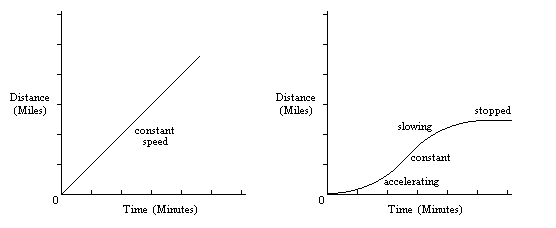
This is a "representation" of reality--of
space and time. Of course we know that reality does not "look" like
this graph. It looks like the images that form in our minds through
our power of sight, touch, hearing, smell, and taste.
Or does it?
In the 20th century we have begun
to realize that what our mind portrays as reality is also only a "representation"
of reality. Our sense of depth, color, temperature, shock or impact,
sweetness, fragrance, etc. are perhaps "translations" of wave-like information
into what our minds recognize as "solid reality." But in fact, the
"solid reality" might only be the waves, energy waves, themselves and not
our translations of those waves into human realities.
Einstein was inclined to go to the
source of reality in his thinking about it: reality as waves of energy--and
how they were configured in order to produce the physical realities of
velocity, momentum, mass.
The Principle of Equivalence:
Acceleration and Gravity
Einstein's Elevator Riddle
Acceleration as Curvature
Acceleration as Curvature in
the Space-Time Dimension
Inertial Frames of Reference
and Accelerating or Changing Frames of Reference
|
 Miles
H. Hodges Miles
H. Hodges
| | |
 (1879 - 1955)
(1879 - 1955) (1879 - 1955)
(1879 - 1955)
 Einstein: An Overview
Einstein: An Overview
 Links to Einstein' Writings and More
Links to Einstein' Writings and More